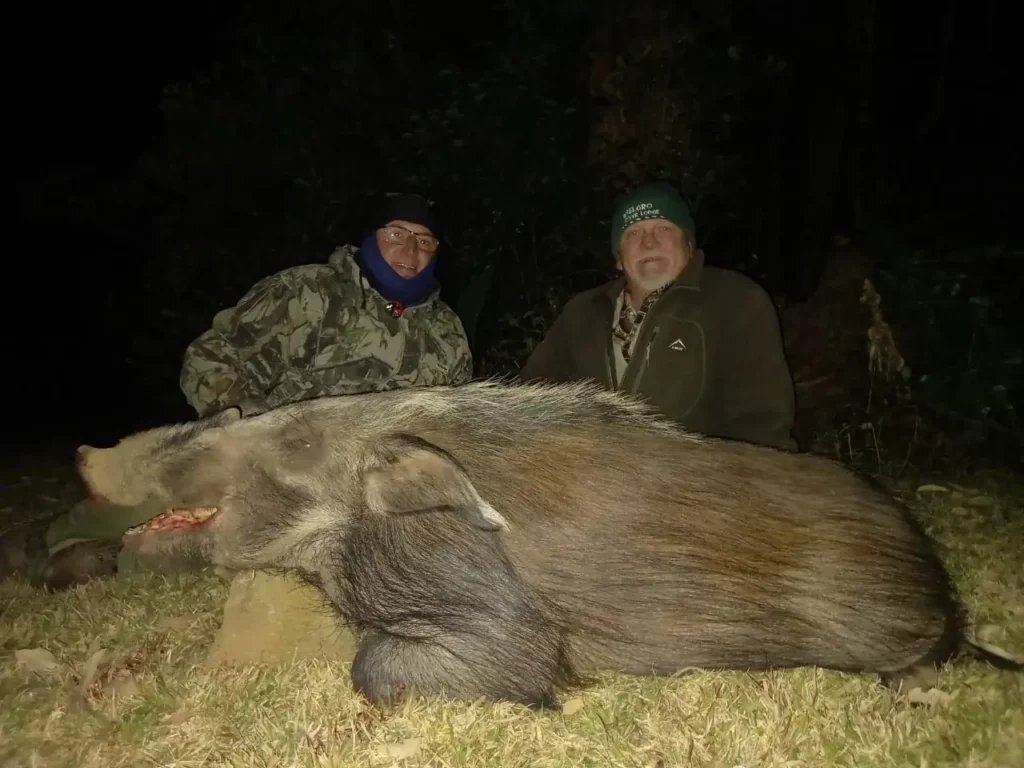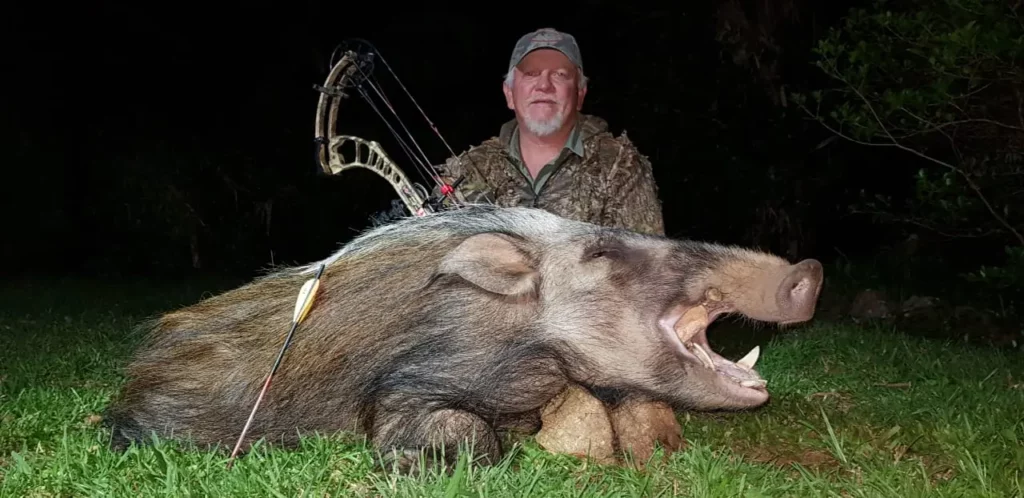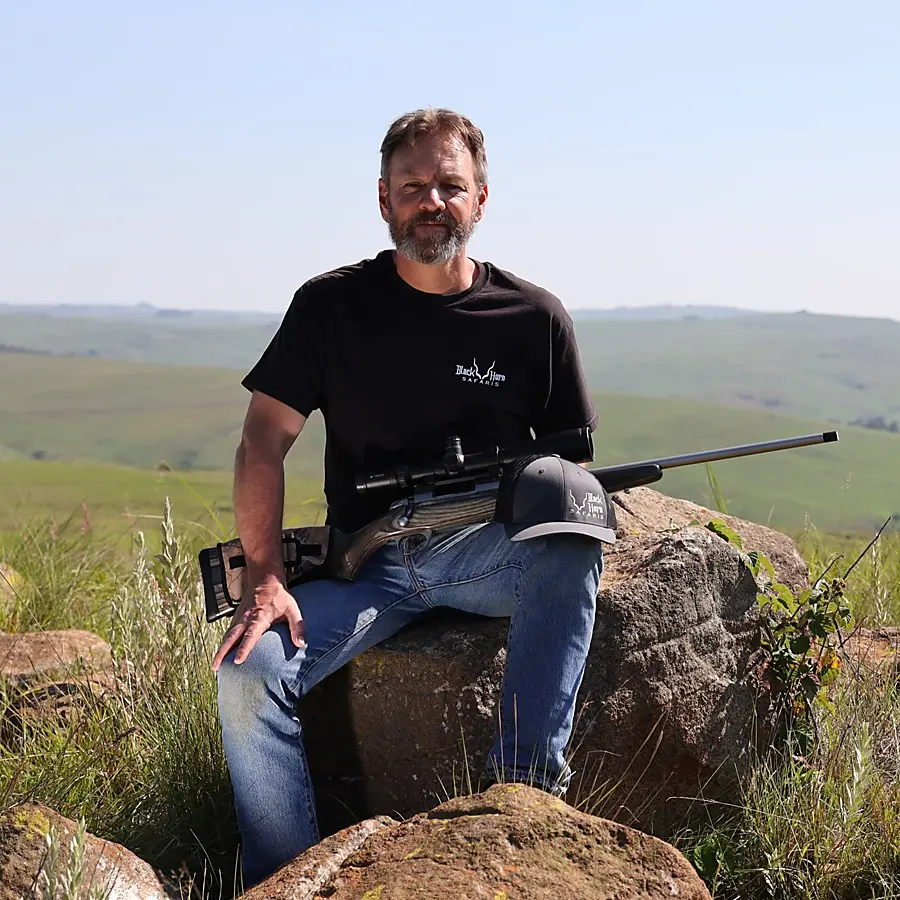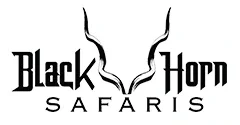Bushpig hunting offers a challenging experience for hunters seeking one of Africa’s most elusive nocturnal creatures. Known for their adaptability and cunning nature, Bushpigs inhabit a diverse range of habitats, from dense riverine forests and bushveld to agricultural lands. Their secretive and primarily nocturnal habits make them a demanding quarry. Pursuing free range Bushpigs often involves the use of well-trained hunting dogs to track and hold the animals, or long nocturnal sits over bait.
Description and Characteristics of Bushpig
The Bushpig, (Potamochoerus larvatus), is a stocky and robust animal found throughout sub-Saharan Africa. With a body length of around 3 to 5 feet and weighing between 90 and 330 pounds, the Bushpig exhibits a wide range of sizes depending on its habitat and food availability. Its coarse, bristly fur ranges from reddish-brown to dark brown, providing it with effective camouflage in its diversified environments. The Bushpig’s distinctive features include a long snout, small pointed ears, and sharp, tusks that serve as both defensive and offensive weapons.
Bushpigs are highly adaptable and can thrive in various habitats, from dense forests to open bushveld and even agricultural areas, where they are known to cause significant crop damage. They are primarily nocturnal animals, relying on their keen senses of smell and hearing to forage for food and evade potential predators. Bushpigs typically live in groups called sounders, comprising adult females, their offspring, and occasionally one or more adult boars.


Bushpig Trophy Size
When pursuing Bushpigs as a hunting trophy, the focus is primarily on the animal’s tusks, which serve as the key indicator of the trophy size. It is not usually possible to determine the length of the tusks before the shot is taken, an old boar is normally chosen from the sounder. Both males and females possess tusks; however, the tusks of males are generally larger and more developed, making them a more sought-after trophy. A boars tusks can reach lengths of up to 9 inches or more, with the upper and lower tusks often exhibiting a noticeable curve and razor sharp edges.
Trophy quality is determined by tusk length and the average would be in the region of 4 –5 inches. Both Rowland Ward and Safari Club International maintain record books for Bushpig. SCI minimum for entry is a score of 12 and RW a minimum of 6 inches on the longest tusk.
World Record
The world record Southern Bushpig stands as a testament to the intriguing diversity of wildlife. Boasting an exceptional RW (Rowland Ward) measurement of 9 inches.
Best Locations for Bushpig
The elusive Bushpig can be found in various locations across sub-Saharan Africa, thriving in a wide range of habitats that include dense forests, bushveld, swamps, and even agricultural lands. Some of the top destinations for Bushpig include South Africa, Zimbabwe, Mozambique, and Zambia, where populations of Bushpigs are abundant.
South Africa offers a wealth of prime locations for Bushpig, thanks to its diverse landscapes and flourishing Bushpig populations. The Eastern Cape is a particularly popular hunting destination due to its mix of dense forests, bush, and mountainous terrain that provide the perfect habitat. Private game reserves and hunting concessions in this region are known for their high population density.
Another notable area for Bushpig is the Limpopo Province in the northern part of South Africa. Its lush bushveld and riverine forests make it an ideal habitat for Bushpigs, offering hunters the opportunity to pursue this nocturnal quarry. KwaZulu-Natal, with its diverse ecosystems ranging from coastal forests to rolling grasslands, also provides excellent opportunities for hunting Bushpigs.
Rifles and Calibers for Bushpig Hunts
Selecting the appropriate rifle and caliber for Bushpig requires careful thought. Bushpigs are not particularly large, but they are robust and tenacious, requiring a caliber that offers sufficient energy transfer and penetration. Popular choices include the 30-30, .308 Winchester, .30-06 Springfield, and 7x57mm Mauser. These calibers provide a balance of power, accuracy, and manageable recoil, making them suitable for targeting the elusive Bushpig.
In addition to rifles, shotguns can also be an effective choice for Bushpig, especially when using well-trained hunting dogs that corner the animal at close range. A 12-gauge shotgun loaded with heavy buckshot or slugs can deliver the necessary stopping power at close range, while offering a wider margin of error in shot placement.
Rifle Scopes and Optics for Bushpig in South Africa
Choosing the right rifle scope is essential for accurate shot placement and a successful Bushpig hunt. Given the Bushpig’s predominantly nocturnal habits, low light conditions often present a significant challenge for hunters, making clarity and light gathering critical considerations. Optics with larger objective lenses, such as 50mm, can provide greater light transmission, allowing for clearer and brighter images in low light environments.
Another important factor to consider is magnification. While high magnification scopes may be suitable for long-range shooting, they can be impractical for Bushpig, which often involves quick, close-range encounters. Low magnification scopes, ranging from 1x to 6x are more appropriate for Bushpig, providing a wider field of view and quicker target acquisition.
It is also essential to choose an optic that can withstand the rugged conditions of hunting, such as rain, dust, and impacts. A sturdy and durable construction that is waterproof and shockproof is essential.
In summary, the best rifle scope or optic for hunting is one that offers clarity, low magnification, and superior light gathering abilities.
Best Shot Placement on Bushpig
Accurate shot placement is imperative when after Bushpigs, particularly as they are primarily nocturnal creatures. Hunters should be familiar with the Bushpig’s anatomy to be able to place a precise shot targeting the vital organs while avoiding bone and heavy shoulder plates or shields found on boars.
The most effective shot placement for Bushpigs is in the chest area, just behind the front legs, aiming for the heart and lungs. Aiming slightly forward of this point can also hit the shoulder blade, damaging the spine and quickly incapacitating the animal.
In low light conditions, it is crucial to use a rifle scope or optic that offers superior light gathering and clarity to ensure accurate shot placement.


Bow Hunting Bushpig in Africa
Bow hunting can be an exciting and challenging hunting experience, requiring stealth, and accurate shot placement. Hunting over bait can be an effective technique for attracting Bushpigs within close range, allowing for a clear shot. However, hunting at dusk and at night can provide the most thrilling and challenging opportunities, as Bushpigs are primarily nocturnal and active during these times.
When pursuing Bushpigs with a bow at dusk or at night over a bait site, it is indispensable to have keen senses, listening for any sounds or movements that may indicate the presence of the animal. It is crucial to remain hidden and undetected while waiting for the Bushpig to approach, often requiring a great deal of patience.
Given the low light conditions, it is important to use specialized bow hunting equipment, such as illuminated nocks, to help track the arrow’s trajectory and locate the animal after the shot. Additionally, hunters should be familiar with the Bushpig’s anatomy, aiming for the chest area, just behind the front legs, to achieve a quick and efficient kill.
Bow Hunting Equipment for Bushpig
Bow hunting Bushpigs requires specialized equipment to ensure accurate shot placement and a successful hunting experience. One important piece of gear is a good bow, preferably with a draw weight of 65 – 75 pounds and a compact design for maneuverability in tight quarters. Compound, recurve, or crossbows all work well.
Another essential item is specialized broad heads, designed to penetrate the tough shoulder and bone of Bushpigs and deliver a lethal shot. Razor sharp fixed blade broad heads of between 125 – 150 gr are recommended.
In low light conditions, such as dusk and at night, it is important to use a special red light that can enhance visibility without spooking the animal. A red light attached to a rheostat that allows the light to gradually increase and decrease if needed. This can help target the animal without startling it, while also providing a clear view of the arrow’s trajectory and impact.
Another important piece of kit is illuminated nocks, which can help hunters track the arrow’s flight path and determine where the impact is on pig hunts.
Bushpig Prices and costs of a Hunting Safari
The cost or trophy fee and hunting prices for a Bushpig is $ 950.
Daily rates for Bushpig Safaris are:
- Hunting 2 on 1 (2 hunters sharing a Professional Hunter) @ $ 350 per hunter per day.
- Hunting 1 on 1 (the hunter has the services of the Professional Hunter to himself) @ $ 450 per hunter per day.
The daily rates include:
- Accommodation in a hunt lodge
- Meals
- Drinks
- The services of a Professional Hunter and his tracker
- Field preparation of trophies
- Delivery of trophies to the Taxidermist
- Road transportation to and from Johannesburg International Airport
Bushpig Packages
A Bushpig and Bushbuck hunting package costs $ 5 050.00 for a 2 on 1 hunting Safari.
This hunting package includes:
- Accommodation
- Meals
- Drinks
- The services of a Professional Hunter and his tracker
- Field preparation of trophies
- Delivery of trophies to the Taxidermist
- Road transportation to and from Johannesburg International Airport
It is possible to add a Bushpig @ $ 950.00 to any other hunting package if they are available in the concession you are hunting in.
FAQ’S Frequently asked Questions on Bushpig
What is the difference between Bushpigs and Warthogs?
Warthogs and Bushpigs are both members of the pig family (Suidae) found in Africa.
Appearance: Warthogs (Phacochoerus africanus) are characterized by their large, wart-like protrusions on their faces, which are actually protective pads of thick skin and gristle. They have long, curved tusks used for digging and defense.
Bushpigs (Potamochoerus larvatus) have a stockier build and have more shaggy sparse bristles. They lack the facial warts of warthogs, and their tusks are smaller and less curved. Their fur is denser and usually reddish-brown in color.
Habitat: Warthogs are primarily found in bushveld and grasslands preferring areas with a good supply of water and minimal tree cover.
Bushpigs prefer denser habitats, such as riverine forests where they can find cover and forage for food.
Behavior: Warthogs are diurnal, meaning they are active during the day.
Bushpigs are mostly nocturnal or crepuscular, meaning they are active during the night or at dawn and dusk. They also live in social groups called “sounders,” but these groups tend to be larger and more cohesive than warthog sounders, often including multiple adult females and males.
Where is the best place to hunt Bushpigs?
The Eastern Cape, Kwazulu Natal and the Limpopo Province are the best places to hunt Bushpig. These three provinces have abundant populations that are feely available to hunters.
What is the best rifle caliber for Bushpig?
The best rifle caliber for Bushpigs is the .308 Winchester, with 180 gr bullets it provides ample power and penetration. Most shots at Bushpigs will be at ranges under 100 meters and the .308 Winchester will get the job done admirably.

Adrian Anderson first obtained his Professional Hunters license in 1991. He is a Big Five and Dangerous Game licensed Professional Hunter and Hunting Outfitter. He has a tremendous love for wildlife and the African bush and enjoys sharing his knowledge with the hunting clients that he guides. Guiding hunters in Africa’s wild places is a passion and seeing them succeed with their goals brings satisfaction. With knowledge of the Safari industry built up over 32 years he is well qualified to give guidance to his hunting clients.

